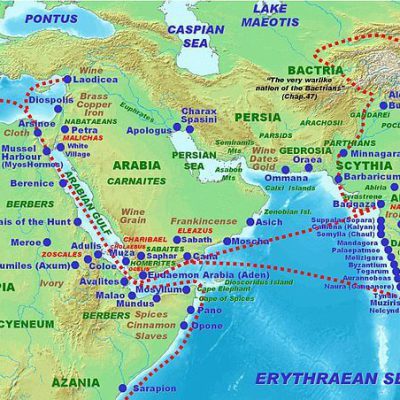Chapters
The ancient Romans maintained trade and diplomatic relations with many countries and peoples; sometimes they fought naturally wars. With the development of the Empire, Roman society was plunged into luxury. Amazing products, exotic animals, sophisticated spices and beautiful materials were brought to Rome. This was best emphasized by Pliny the Elder, a Roman writer from the 1st century CE:
And by the lowest reckoning India, China and the Arabian peninsula take from our empire 100 million sesterces every year – that is the sum which our luxuries and our women cost us.
– Pliny the Elder, Natural History, 12.84
Kingdom of Kush
South of Egypt, the kingdom of Kush, with its capital at Meroe, had for centuries consolidated its power, occupying what is now Sudan and Nubia. Its location assured him of great commercial importance due to the demand for all products that came from Inner Africa (minerals, spices, ivory, gold, precious wood) and from India. The Kushite rulers also reigned in Egypt (Dynasty XXV) between the 8th and 7th centuries BCE until they were driven out by the Assyrians.
The historian and geographer Strabo tells about the conflicts between “Ethiopians” and the Romans in the 1st century BCE, which broke out in Thebes due to the imposition of a new tax, and were calmed down by the prefect Cornelius Gallus. It was not until 29 BCE that Rome accepted the Kushite rulers under its protection, at a time when a buffer state was created between Nubia and Egypt, entrusted to a faithful prince of Rome. However, this concerned a premature balance: taking advantage of the displacements of Roman troops in the following years, the Ethiopians again crossed the border to the north. The Kushites, 30,000 men, attacked Egypt (then under Roman occupation). They seized Elephantine, Syene and File. However, their successes did not last long. Prefect Petronius responded with punitive campaigns, recaptured the cities and chased the Kushites to the former capital – Napata, which he took by storm. Ultimately, peace was negotiated in Samos between Augustus and the queen’s mother Kandake (Candace) Amanirenas. Thousands of Ethiopian slaves were thrown into Roman markets, but the Ethiopians also imprisoned many. The destruction of the capital did not discourage Kandake from organizing further expeditions against the Roman state. In 22 BCE, large Kushite forces moved in with the intention of attacking Qasr Ibrim. Informed in time, Petronius marched south and prepared the city’s defence. Although we do not know about the battle itself, it is certain that the Kushites at one point sent envoys to negotiate peace. The Kushites managed to negotiate a treaty favourable to them, which provided for an increase in trade.
Historiography preserves the memory of one more Roman expedition during the reign of Nero, but this one seems to have had more economic and research intentions than military (conquest). The Kushites as a state began to lose their strength around the 1st-2nd century CE, after continuous fights with the Roman army stationed in Egypt. Gradual economic regression, the decline of the traditional economy and the development of Christianity led to the disintegration of the Kusyce state by the mid-6th century CE.
Garamantes
The Garamantes were a North African Berber people, probably descended from southern Libya, from around the 5th century BCE to the second half of the 7th century CE in what is now the Sahara, in the lands now called Fazzan.
The first information about them is given in his “The Histories” by Herodotus, where he notes that it was “… an exceedingly great nation, who sow in earth which they have laid on the salt”1. Their headquarters were to be located about 30 days south of the Lotophagi, who in turn were to occupy the areas on the Libyan coast. They were to breed oxen with curved horns so that they only grazed backwards to avoid burrowing them on the ground.
The hallmark of Garamants were light horse-drawn chariots on which they traversed the desert to raid black Troglodytes. They were probably the ancestors of today’s Tubu inhabiting the Tibesti Mountains. The purpose of these trips was probably the acquisition of slaves and their sale on the Mediterranean markets. The appearance of the chariots is confirmed by numerous examples of rock art, which is also an invaluable help in reconstructing the course of trade routes. The capital of the Garamant family was Garama, which is currently an archaeological site located about 150 km from the modern city of Sabha.
Romans established direct contact with them, conquering their capital in 19 BCE under the leadership of Cornelius Balbus. In the first century CE, a more peaceful relationship was established with the Garamantes, which resulted in several trips deep into the desert. In 41 CE, Paulinus made an expedition to Senegal through what is today Morocco and Western Sahara. Another, led by Septimius Flaccus, sets off around 50-70 CE from Leptis Magna to reach the region of central Sudan after three months. The next one took place during the reign of Domitian. It was led by Julius Maternus in 90 CE, who headed through Garama (along with King Garamantycki) towards “the land of blacks”. After four months of travel, the country “Agisymba”, where the rhinoceros were to live, reached the country. Currently, it is identified with the regions of Lake Chad. In 202 CE, Septimius Severus won Garama again. The Garamantian state itself had an area of around 150 CE 180,000 km2.
More about Romans’ expeditions into Africa
Nero’s trip on the Nile
According to ancient records, Emperor Nero (ruled CE 54-68) was to organize an expedition to the sources of the Nile River in CE 61. The expedition included a small group of praetorians, who allegedly had to collect the necessary information about the possible possibility of conquering the areas south of Egypt – called Ethiopia by the Romans. During the expedition, the Romans reached the city of Meroe and then reached the Sudd area (present-day South Sudan), where they had problems with the further expedition.
Seneca the Younger or Pliny the Elder mention2 that the sources of the Nile have been proven to be in a great lake in the Sudd area. Pliny stated that considerable knowledge had been gained prior to a possible invasion by Roman forces towards South Africa. Ultimately, the plans were to end with the death of the emperor.
Some historians believe that the Roman detachment may have reached Murchison Falls in Uganda, but this is a controversial thesis.
India
Economic contacts with India still existed during the reign of the Seleucid and Achaemenid dynasties in the Middle East. Relations with India were also maintained by the Greek Ptolemaic dynasty, which controlled the end of the western and northern trade routes with South Arabia and India. With the development of Roman statehood, the “sons of the she-wolf” gradually became more and more involved in trade with India. According to Strabo, trade between Greece and India had no comparison with the subsequent exchange by Rome.
The Ptolemaic dynasty developed trade with India using the ports on the Red Sea. With the rise of the Roman province of Egyptus, the Romans improved trade routes and interstate connections.
The greatest development of trade between Rome and India can be noted during the reign of Octavian Augustus (27 BCE – 14 CE), which allowed for new trade expeditions and geographical discoveries. Trade between Rome and India was mainly by sea.
Intensive trade with such a distant country was possible thanks to the discoveries of the Greek explorer Eudocus of Kyzikos, who in 130 BCE led a number of expeditions in the Arabian Sea, commissioned by the Ptolemaic rulers of Egypt. His discoveries allowed to discover dangerous regions and find suitable routes to Indian ports.
During the reign of Octavian Augustus (27 BCE – CE 14) the main port used for trade with India was Myos Hormos, built by Ptolemy around the 3rd century BCE. Some of the main destinations of merchant ships departing the port were located in the Indus Delta, Muziris and Arikamedu in India, from which spices and precious stones were imported. Strabo mentions that shipping from Myos Hormos to India developed significantly in the 1st century BCE. A total of about 120 merchant ships set off in a given season. Pliny the Elder mourned the flight of Roman gold to the East, estimating it as high as 100 million sesterces per year – an enormous figure corresponding to a fairly significant proportion of Rome’s income.
August in his autobiography mentions that he received messages and respect from India. Rome and the Indian subcontinent, however, were only linked by intensive trade. Trade aside, it should be noted that these two worlds almost ignored each other. As a curiosity, it can be added that a temple was built on the shores of Malabar in tribute to Augustus.
Three major Egyptian ports were involved in the maritime exchange with India: Arsinoe, Berenice Troglodytica and Myos Hormos. The earliest ones were Arsinoe, which was overshadowed by time by Berenice Troglodytica and Myos Hormos.
In India, the main ports were: Barbaricum (now Karachi), Sounagoura (central Bangladesh) Barygaza, Muziris in Kerala, Korkai, Kaveripattinam and Arikameduat the southern tip of the peninsula. The Kodumanal port was also important.
The Romans traded: pepper, ginger, and beryl in exchange for wine, ceramics, glass, bronze, iron, and handicrafts. The Romans also sold thin clothes, patterned fabrics, coral, topaz, incense, silver and gold dishes, glassware, light wine. In return, local residents offered turquoise, lapis lazuli, leather, cotton fabrics, yarn, silk, and indigo. In Barygaz, the Romans bought rice, wheat, sesame oil, cotton and fabrics. Exotic animals were also traded, including: Indian elephants, tigers, birds and monkeys, which are depicted on some Roman frescoes. The evidence of trade cooperation is numerous Roman coins found in India.
Arabian Peninsula
Ancient Romans in the Arabian Peninsula
China
Diplomatic and trade expeditions were also undertaken towards China.












